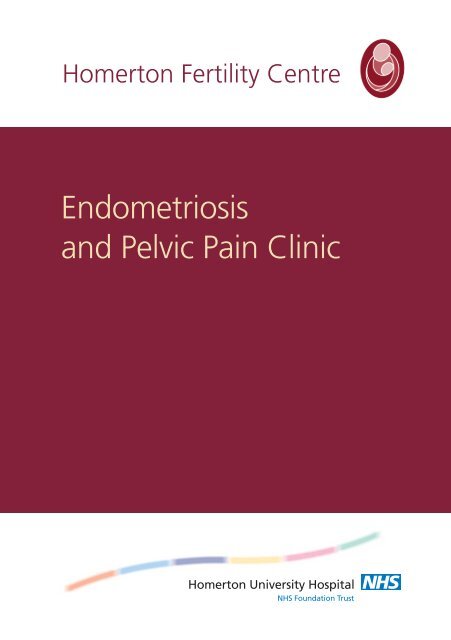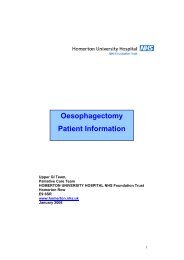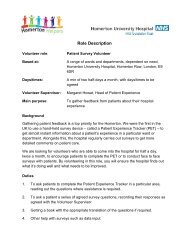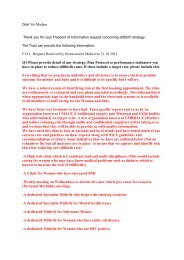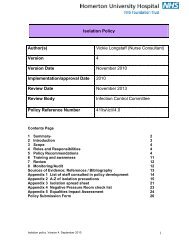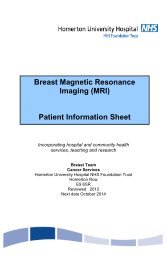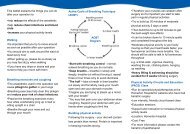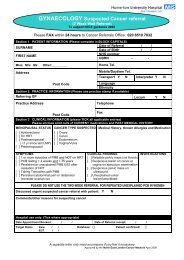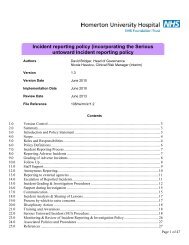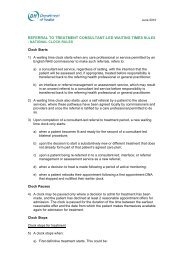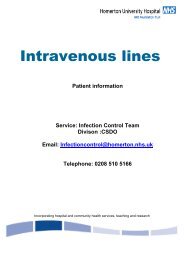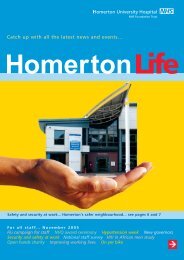Endometriosis booklet - Homerton University Hospital
Endometriosis booklet - Homerton University Hospital
Endometriosis booklet - Homerton University Hospital
Create successful ePaper yourself
Turn your PDF publications into a flip-book with our unique Google optimized e-Paper software.
<strong>Homerton</strong> Fertility Centre<br />
<strong>Endometriosis</strong><br />
and Pelvic Pain Clinic
<strong>Endometriosis</strong> and Pelvic Pain Clinic<br />
<strong>Homerton</strong> <strong>University</strong> <strong>Hospital</strong> <strong>Endometriosis</strong> and Pain<br />
Management Clinic aims to operate an outpatient clinic with a<br />
comprehensive patient centred approach to the care of women<br />
with endometriosis and pelvic pain.<br />
THE TEAM<br />
Mr Anil Gudi<br />
Lead Clinician in<br />
fertility and specialist<br />
in endometriosis<br />
Mr Christian<br />
Barnick<br />
Specialist in<br />
laparoscopic surgery<br />
and endometriosis<br />
Mr Amit Shah<br />
Specialist in infertility
WHAT WILL HAPPEN AT YOUR FIRST APPOINTMENT<br />
At the first appointment a detailed history will be taken. You will be<br />
asked about your symptoms and the extent to which your lifestyle<br />
is being affected. The will form the basis upon which the treatment<br />
will be planned. A detailed treatment plan will be made at this visit.<br />
Information will be given about endometriosis and available<br />
treatment options. At this appointment you will have the<br />
opportunity to discuss about your treatment and any fertility<br />
concerns.<br />
Any necessary investigations will be arranged (ultrasound scan<br />
and blood tests) and a laparoscopy (looking inside the abdomen)<br />
or hysteroscopy (looking inside the womb) will be arranged.<br />
Where appropriate a further appointment will be made in four to<br />
six weeks time to discuss the results of the investigations and plan<br />
the treatment .<br />
RELEVANT LINKS<br />
As a part of the services offered by the <strong>Endometriosis</strong> Centre, you<br />
may also be referred to see one of the other specialities<br />
Fertility Unit (<strong>Homerton</strong> fertility centre)<br />
General surgical team for bowel problems
What is endometriosis<br />
<strong>Endometriosis</strong> is a condition where tissue similar to the lining of the<br />
uterus (womb) is found elsewhere in the body usually the pelvis. It<br />
is a benign (non-cancerous) but a very painful condition which is<br />
characterised by the presence of endometriosis deposits mainly in<br />
the pelvis (the ovary, areas around the womb, on the bladder and<br />
the intestines).<br />
Each month this tissue outside the uterus breaks down causing<br />
internal bleeding which has no way of leaving the body. This leads<br />
to inflammation, pain and the formation of scar tissue.<br />
In the ovary the endometriosis tissue can bleed and cause fluid<br />
contained areas which are called endometriomas (endometriotic<br />
cysts). These cysts are usually detected by an ultrasound scan.<br />
It is estimated that endometriosis is present in between 10% -25%<br />
of young women and may be as high as 35% in women with<br />
fertility problems.<br />
What are the symptoms / signs of<br />
endometriosis<br />
Any woman in the child bearing period and who is having periods<br />
can be affected. <strong>Endometriosis</strong> can usually improve with the onset<br />
of pregnancy or menopause.
Although women may not show any signs of endometriosis, the<br />
common symptoms of endometriosis include:<br />
Painful and or heavy periods.<br />
Painful sex<br />
Pelvic pain<br />
Moderate to severe pain at the time of ovulation<br />
Premenstrual pain<br />
Difficulty in becoming pregnant<br />
Pain when passing urine and or bleeding<br />
Pain and difficult with opening bowels<br />
Bleeding from the bowel with the periods<br />
Fatigue<br />
The majority of women with this condition will experience some of<br />
these symptoms. Some women will have no symptoms.<br />
The amount of endometriosis does not always correspond to the<br />
amount of pain and discomfort.<br />
A small amount of endometriosis can be more painful than severe<br />
disease. It depends on the site of endometrial deposits.<br />
Not being able to get pregnant may be the only symptom in some<br />
cases.<br />
<strong>Endometriosis</strong> is:<br />
Not an infection<br />
Not contagious<br />
Not cancer<br />
<strong>Endometriosis</strong> is very common affecting two million women in the<br />
UK.
Why does endometriosis occur<br />
The exact cause is unknown, although a few theories have been<br />
put forward:-<br />
Retrograde menstruation<br />
Some of the menstrual blood flows backwards down the<br />
fallopian tubes and into the pelvis. Some of this endometrial<br />
tissue implants and causes endometriosis.<br />
Lymphatic or circulatory spread<br />
Endometrial tissue is carried by blood vessels and lymphatic<br />
channels.<br />
Genetic predisposition to the condition<br />
Researchers are looking into the gene which could identify<br />
women predisposed to endometriosis. A woman who has a<br />
mother or sister with endometriosis has a six times greater<br />
risk of developing endometriosis.<br />
Immune dysfunction<br />
There are theories which look at the immune response of the<br />
body which could lead to the development of endometriosis.
How is endometriosis diagnosed<br />
History<br />
A thorough history may highlight suspicion about<br />
endometriosis.<br />
Ultrasound Scan<br />
An ultrasound scan may show the presence of endometriosis<br />
cysts, although not all cysts are caused by endometriosis<br />
and some types of endometriosis may not been seen on a<br />
scan.<br />
<br />
Laparoscopy<br />
This is the only definitive way to diagnose endometriosis. In<br />
this operation a telescope is inserted into the pelvis under<br />
general anaesthesia via a small cut near the navel. This<br />
allows the surgeon to see the pelvic organs and any<br />
endometrial spots or cysts.<br />
Treatment for endometriosis<br />
For effective long term treatment of endometriosis various<br />
treatments are available.<br />
The treatment varies according to various factors:-<br />
Age<br />
The severity of symptoms<br />
The desire to have children<br />
The severity of the disease
The treatment is carried out as a partnership between the patient<br />
and the medical advisers.<br />
The aim of the treatment is<br />
pain relief<br />
reducing endometrial growth<br />
preserving and restoring fertility<br />
delaying the recurrence of the disease<br />
Treatment options are:<br />
Wait and see<br />
If the symptoms are very mild or if menopause is<br />
approaching, this approach may be suitable<br />
Drug treatment<br />
Often these drugs may bring about an improvement in the<br />
pain symptoms<br />
May shrink or slow down the progression of the condition<br />
Delay the recurrence of the disease<br />
Not effective as long term treatment<br />
Commonly used before surgery or before IVF treatment
Commonly used drugs<br />
Testosterone derivatives<br />
Danazol<br />
Gestrinone<br />
Progestogens<br />
Medroxyprogesterone<br />
(Provera)<br />
Dyhydrogesterone<br />
(Duphaston)<br />
Norethisterone<br />
(Duphaston)<br />
GnRH analogues<br />
Triptorelin (Gonapeptyl)<br />
Goserelin (Zoladex)<br />
Leuprorelin (Prostap)<br />
Other Hormonal<br />
Combined oral<br />
contraceptive pill<br />
Mirena coil<br />
Depo- Provera<br />
All hormonal treatments have<br />
side effects. With the exception<br />
of the Mirena coil, Depo-<br />
Provera and the oral<br />
contraceptive pill, the rest of<br />
the drugs do not offer effective<br />
contraception and you are<br />
advised to use the barrier<br />
method.<br />
Side effects<br />
Hot flushes, sweating,<br />
vaginal dryness<br />
Mood wings, sometimes<br />
anxiety<br />
Symptoms of<br />
endometriosis and cyst<br />
size may increase with<br />
the first injection<br />
The first period after the<br />
injection may be irregular<br />
and painful. This usually<br />
settles after the second<br />
injection
Surgical Options<br />
Diagnostic laparoscopy with or without treatment.<br />
Conservative surgery which aims to remove the<br />
endometrial tissue or destroys it, usually via a telescope<br />
or rarely via a laparotomy (When a larger cut is made ).<br />
This can be achieved by diathermy/laser/excision or<br />
ablation depending on severity.<br />
Radical surgery that includes removal of the ovaries and<br />
the uterus. This is considered only if the symptoms are<br />
extremely severe and all other forms of treatment have<br />
been exhausted including surgery. And you do not desire<br />
any more children.<br />
Combination<br />
Often if the surgical treatment has to be divided into two<br />
stages, you may be offered Gonapeptyl depot 3.75mg on<br />
a monthly basis between operations.<br />
These drugs help in making the endometriosis less<br />
bloody, thus enabling a complete excision at the second<br />
operation.<br />
If we are already aware that you have endometriosis , you<br />
may be given these drugs prior to your operation.
Pain Management<br />
Pain Killers<br />
o Neurofen<br />
o Diclofenac (Voltarol)<br />
o Codeine<br />
Neurogenic pain<br />
o Nerve blocks etc<br />
Complementary Therapies<br />
Many women will seek to use complementary therapies to help<br />
with their endometriosis. This may often help, though at present<br />
there are no trials. Options include acupuncture, Chinese or<br />
western herbs, homeopathy and dietary changes.<br />
Surgical Treatment<br />
Laparoscopy and Treatment<br />
Laparoscopy<br />
This is a technique in which a thin telescope is inserted into the<br />
abdomen to inspect the pelvic organs. A 1cm incision is made<br />
under the umbilicus and the abdomen is filled with gas. This<br />
distension allows the surgeon to inspect the pelvic organs to<br />
confirm the diagnosis of endometriosis. Another small incision is<br />
made close to the pubic hairline.
If any endometriosis is seen then a further incision is made to allow<br />
treatment to the affected areas. The surgeon would then either<br />
burn out or remove the affected areas.<br />
Usually you would be discharged on the same day, though in some<br />
cases overnight stay may be needed. The duration of stay<br />
depends on the extent of endometriosis. It is important to realise<br />
that extensive surgery can be achieved through the telescope,<br />
though sometimes a longer duration of stay may be needed.<br />
Treatment centres at <strong>Homerton</strong> <strong>Hospital</strong><br />
Pre-assessment Clinic, prior to surgery where you will be told<br />
about the care in the hospital and details about your<br />
admission and stay. This is a nurse-led clinic and prepares<br />
patients for surgery.<br />
Day Stay Unit (DSU), is an efficiently managed unit with well<br />
trained staff who aim to achieve endometriosis treatment in a<br />
day care setup.<br />
Surgical Centre aims to achieve a fast and efficient way to<br />
preparing patients for surgery. This ensures that it is very<br />
unlikely that your operation will be cancelled for lack of beds.<br />
<br />
Acute Gynaecology Clinic, a weekday service staffed by<br />
experienced doctors and nurses who will be able to see you<br />
either the same day or the next day if you are referred by<br />
your GP with pain.
Aims of treatment<br />
Reduction of pain<br />
Fertility improvement/preservation<br />
Reduction of recurrence<br />
Long term relief<br />
All the treatments are discussed and treatments are individualised.<br />
Detailed explanation about the procedure will be given. You will<br />
also be made aware to any other procedures which may need to<br />
be carried out. In cases of extensive endometriosis the procedure<br />
may be done in two stages to achieve a significant cure.<br />
If you are trying to get pregnant or are thinking of it in the near<br />
future, we will check for any fertility problems at the same time and<br />
would be able to give you more information. If advanced fertility<br />
treatment is needed you would be managed by our fertility unit<br />
which can advise you regarding the treatment. You may wish to<br />
continue your fertility treatment at the Unit. Quite often the health<br />
authorities may fund the treatment.
Your Treatment<br />
Bowel preparation<br />
You may be given medicine to clean up your bowel to reduce the<br />
change of bowel damage during surgery.<br />
Minor surgery<br />
Minor surgery will involve inspection and burning away the<br />
endometriosis tissue or spots.<br />
Adhesions(Scar tissue) would be divided or removed<br />
An endometriomas or chocolate cyst (Cyst filled with<br />
Endometriotic fluid) will be opened and drained. The cyst will<br />
then be removed. Care will be taken to preserve as much<br />
normal ovarian tissue as possible.<br />
Major surgery<br />
This may still be laparoscopic.<br />
Cutting away the endometriosis affected tissue<br />
Releasing ovaries<br />
Releasing adhesions and removing the tissue affected by<br />
endometriosis around the back and the side of the uterus,<br />
around the bladder and ureter and the space between the<br />
rectum and the vagina<br />
Dissecting the ureters(Tubes that carry urine from the<br />
kidneys to the bladder) to be able to remove<br />
endometriosis tissue
Bladder disease<br />
If severe endometriosis affects the bladder (Anterior disease) or<br />
is found close to the bladder then<br />
A cystoscopy (Inspecting the bladder with a scope) may be<br />
done<br />
The bladder may need to be opened to remove the<br />
endometriosis<br />
A catheter may be retained inside the bladder and the<br />
bladder will be rested for about 10 days.<br />
You will be advised by the consultants in the urogynaecology<br />
department.<br />
Bowel disease<br />
If you have severe disease involving the bowel, you will be offered<br />
an appointment at the <strong>University</strong> College London endometriosis<br />
Unit. This unit specialises in the laparoscopic treatment of severe<br />
endometriosis involving the bowel.<br />
A referral will be sent to the UCLH and a date for surgery will be<br />
arranged by the UCLH. This will avoid a long wait for surgery.<br />
We will discuss the surgery with you and explain the procedures<br />
which may need to be undertaken. There is a possibility that you<br />
may need two surgeries to clear the endometriosis.
During surgery<br />
The bowel will be dissected free and the endometriosis may<br />
need to cut away.<br />
If this happens the bowel may need to be rested for around<br />
one week.<br />
There is a possibility if a cut on the abdomen and a<br />
temporary colostomy (getting the bowel out through the<br />
abdomen) may need to be carried out. This may require<br />
another surgery to reverse the colostomy.<br />
If this is a possibility of this happening, we may not carry out<br />
the procedure at the same time, but may remove as much<br />
endometriosis as we can and plan the bowel surgery at<br />
another date after you have seen the bowel surgeon and are<br />
made aware of the recovery and effects of the surgery.<br />
If you have been through repeated surgery elsewhere and if<br />
the bowel is involved in endometriosis, this form of surgery<br />
may be needed to relieve your symptoms.<br />
Surgical risks<br />
This will depend on the type of surgery and extent of<br />
endometriosis. As with all surgery the associated risks may<br />
include. These risks are very small and in mild to moderate<br />
disease may occur in 1:500 cases for severe complications.<br />
Damage to bladder and ureters. If the ureters are<br />
damaged then a major surgery will have to be carried out<br />
and a stent may need to be inserted
Damage to bowel and correction<br />
Damage to nerves and blood vessels<br />
Infection<br />
Risk to delayed complications including bowel injury and<br />
haematoma (Collection of blood in the abdomen) which<br />
can occur up to two weeks after the procedure.<br />
If any of these complications occur, a laparotomy (open<br />
surgery through a larger cut) may need to be undertaken to<br />
correct the damage or to stop bleeding.<br />
If you experience sudden or increasing pain at home, or have<br />
vomiting or feel unwell please seek medical advice<br />
immediately.<br />
During daytime hours you may contact the acute gynaecology<br />
service and the accident and emergency out of hours.<br />
The use of GnRH analogues (Gonapeptyl)<br />
in the treatment of endometriosis<br />
Gonapeptyl (triptorelin) virtually stop all ovarian activity. They stop<br />
the ovaries working and thus reduce the production of oestrogen.<br />
This results in a temporary but reversible state of menopause (not<br />
actual menopause).<br />
These drugs are used prior to surgery to shrink and reduce the<br />
vascularity in the endometriosis and to facilitate surgical treatment.
These drugs are used two to six months but may be sometimes<br />
used longer. Most women feel better at the end of the treatment. If<br />
the drug is used longer, additional hormone replacement therapy is<br />
given to prevent osteoporosis and menopausal symptoms.<br />
Gonapeptyl is given as an injection once a month for two to six<br />
months.<br />
It is important that you are not pregnant when you begin the<br />
treatment.<br />
In the initial stages of the treatment, symptoms may get worse<br />
due to the initial rise of hormones but will reduce as treatment<br />
continues.<br />
Gonapeptyl is not a cure, as the symptoms recur when the<br />
treatment is discontinued, although the interval of<br />
reappearance of symptoms varies.<br />
Contraindications<br />
Gonapeptyl or Zoladex must NOT be taken if:<br />
You are pregnant or suspect that you are pregnant<br />
You are breast feeding<br />
You have undiagnosed abnormal vaginal bleeding<br />
The use of Gonapeptyl or Zoladex does not guarantee<br />
contraception.
Side effects<br />
Hot flushes<br />
Decreased sex drive<br />
Mood changes<br />
Insomnia<br />
Headache<br />
Breast tenderness<br />
Insomnia<br />
Osteoporosis with longer use<br />
Within a few weeks of completing treatment the side effects<br />
reduce.<br />
<strong>Endometriosis</strong> and infertility<br />
There is a definitive link between endometriosis and infertility.<br />
<strong>Endometriosis</strong> is seen in about 20 to 25% of women referred to the<br />
fertility clinics worldwide.<br />
<strong>Endometriosis</strong> and infertility is often linked. <strong>Endometriosis</strong> causes<br />
infertility in various ways:<br />
Distorts the pelvis organs<br />
Changes the position of tubes and ovaries and creates<br />
adhesions<br />
Alters hormonal functions make the local environment<br />
worse<br />
Interferes with Ovulations<br />
Causes decreased implantation
For endometriosis with pelvic pain a combination of medical and<br />
surgical treatment is the standard.<br />
The treatment of endometriosis in infertile women leading to clear<br />
improvement is more complex and should be under the care of<br />
fertility team.<br />
Stage 1 and 2 endometriosis<br />
These are early stages of endometriosis and can cause infertility.<br />
Surgical treatment of stage 1 and 2 endometriosis improves<br />
pregnancy rates. Excision or ablation of endometriosis both<br />
improve pregnancy rates.<br />
How long should I wait after surgery to get pregnant<br />
This depends on your age and how long you have been trying for a<br />
pregnancy. If you are over 34 years of age then waiting for a long<br />
time after surgery will not improve pregnancy rates. Generally<br />
fertility rates decrease after 35 years of age, but in women with<br />
endometriosis, the decline in fertility rates may be earlier.<br />
It is important that you have a FSH test done (Baseline hormones)<br />
and Anti-Mullerian Hormone (tests ovarian reserve). This will gives<br />
us an idea about your ovarian reserve and whether you have time<br />
to wait or should think of earlier treatment.<br />
There is evidence that proceeding with treatment either<br />
1. Stimulation of the ovaries and insemination of sperm (IUI)<br />
2. In-vitro fertilisation (IVF)
It is important for you to ask questions regarding your concerns<br />
about infertility. Often women go through repeated surgeries<br />
before being referred to the fertility department. At this clinic you<br />
can have your fertility accessed and avail of fertility advice if<br />
required.<br />
Stage 3 and 4 endometriosis<br />
These represent the more severe from of endometriosis. There is<br />
adequate evidence that repeated surgery does not improve the<br />
chances of pregnancy.<br />
1. If pelvic pain and fertility both are a concern, then surgery<br />
followed by fertility treatment gives the best result<br />
2. In cases where previous surgery has been done or there is<br />
long standing infertility, IVF gives better results. We would<br />
recommend that you should seriously consider fertility<br />
treatment following surgery.<br />
IVF treatment removes gametes for a hostile environment created<br />
by endometriosis and maximises conception<br />
Are success rate with endometriosis lower in IVF<br />
Compared to other patients, there is some evidence that<br />
pregnancy rates in IVF may be lower in women with endometriosis<br />
There is evidence that women require a higher dose of drugs to<br />
stimulate the ovaries in endometriosis.
Ovarian reserve may be decreased in women with severe<br />
endometriosis and stimulation of ovaries may produce fewer eggs.<br />
There is recent evidence that in women with endometriosis,<br />
implantation of the pregnancy may be affected.<br />
Can pregnancy rates be improved in endometriosis<br />
There is evidence that in cases of severe endometriosis, long<br />
suppression of ovaries by Gonapeptyl or such drugs may improve<br />
implantation.<br />
Before you proceed for your ivf cycle, you will be given three<br />
courses of Gonapeptyl after which you will be started on the IVF<br />
drugs. This is a variation of the long protocol.<br />
We will also be checking your AMH (Anti-mullerian hormone)<br />
which will allow us to fine tune your IVF drug dose and may<br />
improve pregnancy rates.<br />
We will avoid operating on small cysts, since it may further<br />
decrease ovarian reserve.<br />
Can endometriosis worsen after fertility treatment<br />
During fertility treatment, the medications make the ovaries enlarge<br />
and the hormonal rise may worsen endometriosis in some women.<br />
This is a short term rise many women will feel relieved of the<br />
symptoms in a few weeks.<br />
If you were to fall pregnant these symptoms will get better.
<strong>Endometriosis</strong> cyst (endometrioma)<br />
This is the commonest cyst in the ovary that requires treatment.<br />
Endometriomas can cause pain and infertility. Repeated surgery<br />
on endometriomas, will decrease ovarian reserve and thus<br />
decrease fertility.<br />
These ovarian cysts can either be treated by cyst removal<br />
(cystectomy) or cysts destruction (drainage and coagulation).<br />
Which type of surgery is better<br />
Cystectomy – reduces the risk of the cyst coming back<br />
(Recurrence) but there is a possibility of more ovarian tissue being<br />
destroyed<br />
Draining and coagulation (burning) – this destroys less ovarian<br />
tissue and may be better for fertility treatment. The risk of the cyst<br />
coming back is higher.<br />
This decision would be made during discussion with you and your<br />
desire for having a baby.<br />
There is good evidence that treatment of the endometriosis cyst<br />
does improve pregnancy rates if the tubes are open<br />
It is extremely important that you tell the doctor that you are keen<br />
to consider fertility treatment after the surgery. This will allow you<br />
to get a tailored treatment plan that will give you the options of<br />
fertility treatment and whether it can be funded on the NHS.
Preventing recurrent of endometriosis<br />
<strong>Endometriosis</strong> is a disease that can recur with the painful<br />
symptoms coming back.<br />
About 25% of women are likely to have recurrence of<br />
endometriosis within five years. In a few women, this recurrence<br />
comes earlier. It is important to discuss the various methods of<br />
reducing the risk of recurrence.<br />
The different methods are set out below.<br />
Suppressive treatment<br />
In this treatment the ovarian hormones are suppressed, thus<br />
lowering the risk of endometriosis recurring. Painkillers reduce<br />
pain but do not prevent the recurrence of endometriosis.<br />
1. Combined contraceptive pill - these given in three monthly<br />
courses are the most effective means of suppressing<br />
endometriosis. It may cause some breakthrough bleeding<br />
and may not be advisable in women who cannot take the pill.<br />
2. Progeterone only pill - these contain only one hormone and<br />
have reasonable effectiveness<br />
3. Gonapeptyl Depot - these drugs should not be given for<br />
more than six months continuously. These is a risk of<br />
osteoporosis with its over six months usage.<br />
4. Depo-provera – is reasonably effective, but can cause<br />
abnormal bleeding,
5. Mirena contraceptive device – if other drug preparations are<br />
not possible then the Mirena system may be used<br />
Mirena for endometriosis<br />
Mirena is a small T-shaped intrauterine contraceptive device that<br />
has been used for endometriosis. It contains the hormone<br />
progesterone which is released into the uterus over a period of 5<br />
years.<br />
It is a very effective contraceptive and few studies indicate that it is<br />
effective for the treatment of endometriosis<br />
How does it work<br />
The Mirena probably works by suppressing the growth of the<br />
endometrial implants causing it to waste. It may also reduce some<br />
endometriosis induced inflammation (swelling).<br />
The Mirena can some times stop ovulation, although this is not<br />
always the case.<br />
Small clinical trials have indicated that the Mirena reduces period<br />
pain over three years and the most improvement is seen in the<br />
first 12- 18 months.<br />
Often you will be offered this coil when you consent for surgery. If<br />
you do not desire any children in the immediate future it is<br />
extremely important that a plan be made to reduce the risk of<br />
endometriosis recurring.
For further information:<br />
Please contact Mr Christian Barnick or Mr Anil Gudi if you wish to<br />
discuss any aspect of the information outlined in the endometriosis<br />
leaflets or your treatment in more detail.<br />
You may write to:<br />
<strong>Homerton</strong> Fertility Centre<br />
<strong>Homerton</strong> <strong>University</strong><br />
<strong>Hospital</strong><br />
London<br />
E9 6SR<br />
The <strong>Endometriosis</strong> Clinic<br />
Dept. of Obstetrics & Gynaecology<br />
<strong>Homerton</strong> <strong>University</strong> <strong>Hospital</strong><br />
London<br />
E9 6SR<br />
For further information:<br />
The National <strong>Endometriosis</strong> Society<br />
Suite 50<br />
Westminster Palace Gardens<br />
1-7 Artillery Row<br />
London<br />
SW1P 1RR<br />
ENDOMETRIOSIS.ORG<br />
Tel: 0870 7743665<br />
www.endometriosis.org<br />
Tel: 0207 222 2781<br />
Helpline: 08088082227<br />
www.endo.org.uk<br />
Author – Mr A Gudi<br />
Date – May 2010<br />
Review Date – May 2012


